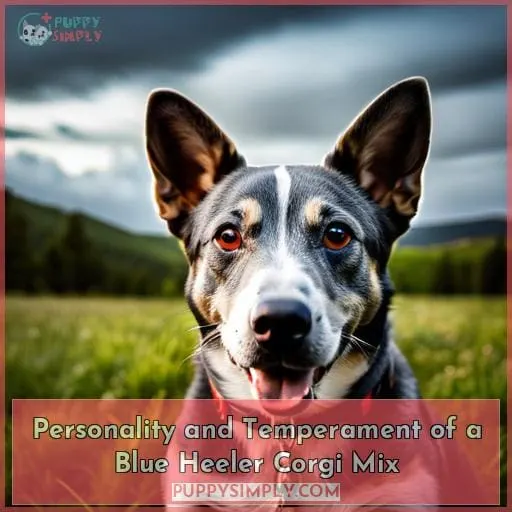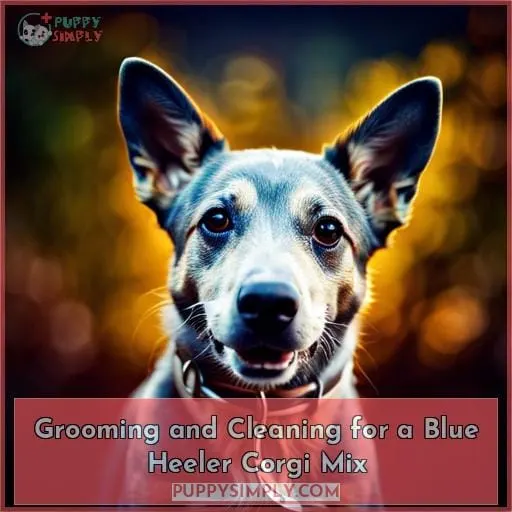This site is supported by our readers. We may earn a commission, at no cost to you, if you purchase through links.
 Are you looking for a loyal, intelligent, and active pup to add to your family? Consider the Blue Heeler Corgi mix! This unique cross between an Australian Cattle Dog (also known as a Blue Heeler) and Welsh Corgi is sure to win over your heart with its friendly personality.
Are you looking for a loyal, intelligent, and active pup to add to your family? Consider the Blue Heeler Corgi mix! This unique cross between an Australian Cattle Dog (also known as a Blue Heeler) and Welsh Corgi is sure to win over your heart with its friendly personality.
Not only will this pup bring plenty of joy into your home, but it’s also high in intelligence, which makes training easy-peasy. With its short stature yet strong build, the Cowboy Corgi is well-suited for almost any living condition from apartments or small homes all the way up to farms and ranches.
And if that wasn’t enough already – they are just so darn cute! So what exactly does owning one of these cowboy pups entail? Read on below as we discuss traits, health concerns, and more about this hybrid breed!
Table Of Contents
- Key Takeaways
- What is a Blue Heeler Corgi Mix?
- Blue Heeler Corgi Mix: Parent Breeds
- Physical Appearance of a Blue Heeler Corgi Mix
- Size and Height of a Blue Heeler Corgi Mix
- Coat Colors and Types of a Blue Heeler Corgi Mix
- Personality and Temperament of a Blue Heeler Corgi Mix
- Training Tips for a Blue Heeler Corgi Mix
- Exercise Requirements for a Blue Heeler Corgi Mix
- Living Conditions for a Blue Heeler Corgi Mix
- Grooming and Cleaning for a Blue Heeler Corgi Mix
- Health Issues in a Blue Heeler Corgi Mix
- Pros and Cons of Owning a Blue Heeler Corgi Mix
- Compatibility of a Blue Heeler Corgi Mix With Kids and Other Pets
- Adaptability of a Blue Heeler Corgi Mix to Apartment Living and Weather
- Cost of Owning a Blue Heeler Corgi Mix
- Conclusion
Key Takeaways
- Blue Heeler Corgi Mix is a crossbreed of an Australian Cattle Dog and a Welsh Corgi.
- They have a medium size and a lifespan of 12-15 years.
- They require regular vet check-ups, grooming, and have potential health concerns.
- Blue Heeler Corgi Mix needs regular exercise, is adaptable to different living conditions, and is compatible with kids and other pets.
What is a Blue Heeler Corgi Mix?
You’ve heard of them, but do you know what makes this beloved hybrid so special? Get ready to discover the loyal and intelligent companion that is the Blue Heeler Corgi mix!
A medium-sized dog with an average life expectancy between 12 to 15 years, they can weigh anywhere from 15 to 85 pounds when fully grown. The physical appearance of these dogs can vary greatly due to their hybrid nature; however, they generally have a double coat if both parents had a double layer.
Their color typically comes from their parent breeds – white, brown, black for Corgis and black, grey, tan, or white for Australian Cattle Dogs (Blue Heelers).
Temperament-wise, these pups are friendly with great intelligence, which makes training easier than some other breeds. They also need plenty of socialization as puppies in order not to become too timid or anxious later on in life.
Although they may bark occasionally at unfamiliar noise, it’s important owners keep control over excessive barking habits by providing adequate exercise and playtime activities such as fetching a ball or tugging toys around the yard!
Regarding healthcare needs, it’s best practice to take your pup for regular vet check-ups since there is always the potential risk of inheriting genetic problems like Hip Dysplasia or Cataracts from either parent breed.
All things considered, Blue Heeler Corgi Mixes make fantastic family pets who are suitable for apartment living, provided ample exercise opportunities are available nearby.
Blue Heeler Corgi Mix: Parent Breeds
A Blue Heeler Corgi Mix is a hybrid of two distinct breeds: the Australian Cattle Dog and the Welsh Corgi. Both have histories steeped in herding, intelligence, trainability, and adaptability that make them highly sought-after companions today.
This mix brings together all these traits to create an amiable canine perfect for families or individuals seeking an active pup with loyalty and affection.
Australian Cattle Dog History
Discovering the history of the Australian Cattle Dog, you’ll find an iconic breed that is loyal and hardworking. Originating in Australia in the 19th century, early cattle herding is where these dogs got their unique working traits from.
Breeders began combining different herding breeds, such as Dalmatians and Collies, to create a new breed with superior herding instincts. This resulted in a resilient dog with strong physical characteristics for tough work conditions, like heat or long hours of standing guard over cattle herds.
During this time, their coat became double-layered to provide better protection against harsh climates. They also developed weatherproof features, like webbed feet, which allowed them to swim after herds if needed.
With continued breeding trends came selective training methods that improved intelligence and trainability. These methods also accentuated size standards, making them easily recognizable from other breeds used for cattle handling at the time.
All of these developments have led us to today’s modern form of this beloved four-legged friend!
Corgi History
Uncovering the history of Corgis, you’ll find an ancient breed originating from Wales with a loyal and friendly disposition. Evolutionary lineage dates back to 1200 AD, and these herding instincts are still very apparent in their behavior today.
Two distinct breeds were developed: the Cardigan Welsh Corgi (with a longer body) and the Pembroke Welsh Corgi (with a shorter body). Both have unique appearances due to their short legs, long bodies, erect ears, and thick coats that come in various colors like white, brown, black, or tan.
Their compact size makes them ideal for homes with limited space while also being great companions on outdoor adventures! Intelligence combined with herding instincts made them incredibly useful on farms, but they’ve since become cultural icons as well.
The dependable nature of this beloved four-legged friend is undeniable – always ready for an adventure or just cuddles at home!
Physical Appearance of a Blue Heeler Corgi Mix
Gaining an understanding of the physical appearance of a Blue Heeler Corgi Mix can help you decide if this breed is right for your family. This hybrid breed usually has unique features due to its combination of parent breeds.
A common trait among them is their double-layered coats in shades similar to both parents – mainly white, brown, and black from the Corgi and grey, tan, or white from Blue Heelers.
Their adaptability, however, makes them suitable for most living conditions as long as exercise requirements are met regularly. In terms of temperament, these hybrids tend to be loyal and energetic companions with intelligence levels above average! They will have no problem adapting quickly when it comes time for training but may bark more than usual without proper control – something all potential owners should keep in mind when considering this pet choice.
Additionally, their coat colors vary significantly depending on what traits each parent passed down, which could make finding one with desired color patterns tricky but exciting nonetheless! With regular grooming needs such as brushing two or three times weekly plus monthly baths using quality dog-specific products, you’ll ensure your pup remains healthy throughout his lifetime, which is estimated around 12-15 years old.
On top of that, the initial cost can range anywhere between $1000-$2500, while annual expenses hover near $485-$965.
Size and Height of a Blue Heeler Corgi Mix
You’ll find that a Blue Heeler Corgi Mix can range in size from 15 to 17 inches at the shoulder and weigh between 15 to 85 pounds. This hybrid dog breed is usually medium-sized, typically around 15-20 inches when it reaches maturity.
It’s an amiable pooch with plenty of energy, making exercise requirements important for its overall health and well-being. Grooming techniques are also necessary for this particular breed. Regular brushing with a slicker brush using specialized shampoo and conditioner will help maintain healthy skin and coat while controlling shedding levels.
Training challenges may arise due to its intelligence; however, early potty training along with obedience classes can ensure your pup grows up into an obedient adult dog! Health considerations should also be taken into account, such as potential genetic problems like hip dysplasia or cataracts, which could develop over time depending on growth stages.
Compatibility-wise, they get along great with kids while having no issues adapting to apartment living – just make sure they’re getting enough exercise each day! All in all, the Blue Heeler Corgi Mix is renowned for being friendly yet alert.
Coat Colors and Types of a Blue Heeler Corgi Mix
Discover the beautiful coat colors and types that make up a Blue Heeler Corgi Mix – from dazzling black to warm tan, these pups are sure to turn heads! The variety of coats comes from their parent breeds.
Blue Heelers have a short smooth coat in shades of black, grey, tan, or white. Corgis, on the other hand, boast luxurious double-layer coats in white, brown, or black. With such unique combinations available for this hybrid breed, you can expect them to be quite varied.
Grooming needs will vary depending on which type of coat your pup has inherited, but all should require regular brushing and occasional trips to the groomer for trimming. Control shedding by using quality brushes like a slicker brush, as well as specialized shampoos and conditioners made specifically for dogs.
Be sure that whatever products used, they are gentle enough not to irritate your pup’s skin, who may already be prone to depression or anxiety if left alone too much without attention.
Your companion is also suited for apartment living due to its medium size, typically 15-20 inches at shoulder. Although exercise is still necessary each day if possible, so keep an eye on how active he/she gets when around other pets and children alike – patience being key here with both groups! As far as adaptability goes, they’re able to handle different weather conditions.
However, extreme heat may cause distress, making cold climates more suitable environments overall. This keeps costs down year-round since no extra equipment would need purchasing beyond what’s needed inside the home itself.
Personality and Temperament of a Blue Heeler Corgi Mix
The Blue Heeler Corgi Mix is an amiable and intelligent dog breed that can make for great family pets. They’re affectionate, easy to train, and highly adaptable to different environments. Training approaches with the Blue Heeler Corgi should be positive reinforcement-based as they respond best when praised for good behaviors.
Socialization benefits will help these dogs become better accustomed to meeting new people or animals in a safe setting.
Exercise preferences vary depending on size, but all sizes require some form of daily physical activity given their active personalities and need for mental stimulation techniques like puzzle toys or hide-and-seek games with humans or other animals alike!
Traits:
- Intelligence: High intelligence means they learn quickly.
- Trainability: Positive reinforcement works best; they respond well to praise.
Adaptability: Suits apartment living (depending on size); adapts well to weather conditions.
Affectionate: Their friendly and loyal nature makes them great companions.
Training Tips for a Blue Heeler Corgi Mix
Training your pup to be obedient and potty trained is an important part of owning a Blue Heeler Corgi mix. This active pup makes for an ideal family dog, as they’re loyal, friendly, and intelligent. To ensure the best success with training, it’s important to employ positive reinforcement techniques such as treats or verbal praise when your puppy follows commands correctly.
Here are some tips on how to train your Cowboy Corgi:
- Crate Training: Set up a comfortable crate to help minimize accidents in the house while you’re away or unable to supervise them throughout the day!
- Positive Reinforcement: Reward good behavior with treats or verbal praise to encourage more desirable behaviors from your Welsh Corgi.
- Socialization Techniques & Leash Manners: Introduce them early on in life to foster relationships between people, increase their comfort level around strangers, and teach leash manners.
- Mental Stimulation & Exercise: Provide enrichment activities like puzzle toys to give them mental stimulation and keep them engaged.
Exercise Requirements for a Blue Heeler Corgi Mix
A Blue Heeler Corgi Mix needs plenty of exercise and activity to stay healthy and happy. They require interactive games, mental stimulation, and outdoor activities to stay entertained. It is important to maintain a good balance of playtime for their physical health and mental wellbeing.
Regular exercise also helps prevent behavioral issues like excessive barking or destructive behavior at home.
An ideal exercise routine for a Blue Heeler Corgi Mix should include 30-45 minutes of exercise twice a day. Indoors, you can engage them in interactive games like fetch or tug-of-war. Outdoors, take them for walks around the neighborhood or to a dog park where they can socialize with other dogs while getting physical activity.
The cost of owning a Blue Heeler Corgi Mix can vary depending on factors such as coat color, size, and history. However, you should expect an initial cost between $1000 – $2500, followed by annual costs averaging $485 – $965 (including vet visits).
Since Blue Heeler Corgi Mixes come from breeds with double coats, regular grooming is essential for hygiene and appearance. It is also important to be diligent in caring for potential genetic illnesses like Hip Dysplasia & Cataracts throughout their lifespan of 12-15 years.
With adequate love, attention, and lots of interactive exercises, your Blue Heeler Corgi mix pup is sure to bring joy into your life every single day!
Living Conditions for a Blue Heeler Corgi Mix
You’ll need to provide a spacious living environment for your Blue Heeler Corgi Mix pup, as they’re like energetic bundles of joy! Training challenges and socialization needs will require an experienced owner or professional help.
Exercise routines should be implemented early on to avoid behavioral issues. Mental stimulation can come from playtime activities, such as fetching toys and going for long walks.
Grooming techniques should also be considered to keep their double coat healthy. Regular brushing with a slicker brush is recommended, along with monthly bathing using specialized shampoo and conditioners.
Cost-wise, the initial purchase price could range between $1000-$2500 per year. However, average annual costs are usually around $485-$965, depending on health care needs. These needs may include Hip Dysplasia, Cataracts, or other genetic problems that may occur due to its hybrid nature.
Separation anxiety is common, so it’s important that they have plenty of attention. Otherwise, depression can set in quickly. This makes them less than ideal pets for novice owners who don’t have much time available during the day.
Apartment living might suit this breed depending on size. Ultimately, providing adequate space both indoors and outdoors will ensure that your Blue Heeler Corgi mix stays happy all year round!
Grooming and Cleaning for a Blue Heeler Corgi Mix
As a Blue Heeler Corgi Mix owner, you must take special care when grooming your pup. To keep their coat healthy and beautiful, it’s important to brush them regularly with the right tools. A slicker brush can help remove debris from their double layer of fur if both parents have a double coat.
A specialized shampoo and conditioner are also necessary to maintain their coat’s natural oils without over-drying the skin or stripping away any protective nutrients they need for good health.
Bathing frequency should be once every month using quality dog-specific products that won’t irritate sensitive skin and eyes while getting rid of dirt build-up on coats or paws.
It’s also wise to invest in some basic puppy costs such as flea & tick prevention medication before even considering puppies for sale so you’re prepared when bringing home your new bundle of joy!
Health Issues in a Blue Heeler Corgi Mix
Considering a Blue Heeler Corgi mix? Health issues should be a top priority when making your decision. Both the Blue Heeler and Corgi breeds have their own genetic health concerns, as well as potential problems that can arise from combining them in one hybrid dog.
It is important to research both parent breeds’ predispositions for illness before deciding whether this mixed breed is right for you.
Blue Heeler Health Issues
Be aware that your hybrid pup may be prone to health issues such as hip dysplasia, cataracts, and more, so make sure you give them the care they need.
Common ailments can be prevented with regular preventive care, including vaccinations and check-ups. Nutrition considerations are also important for a healthy lifestyle; ensure your pup gets adequate nutrients from their diet.
Exercise is also key in preventing genetic predisposition diseases, so take time to play with your pup daily! Regular vet visits will allow you to monitor any changes in health or behavior due to exercise impact on the overall wellbeing of the Blue Heeler Corgi Mix breed.
Take proactive steps now for long-term pet happiness later!
Corgi Health Issues
Due to their hybrid nature, your Blue Heeler Corgi Mix may be prone to certain genetic health issues associated with both parent breeds, such as hip dysplasia, cataracts, and other vision problems.
Common health considerations for this breed include:
- Preventive care through regular vet checkups.
- Dietary considerations that support genetic predispositions.
- The impact of exercise on overall physical well-being.
Proper diet and exercise are essential in maintaining a long, healthy life for your pup! With preventive measures taken throughout its lifetime and early intervention when needed, you can ensure that your beloved Blue Heeler Corgi Mix will be around for many years of joyous companionship.
Blue Heeler Corgi Mix Health Issues
You need to be aware of potential health issues in this hybrid breed, such as hip dysplasia, cataracts, and other genetic problems. Intelligence and trainability make the Blue Heeler Corgi Mix an adaptable pet for many households.
But preventive care is essential to keep them healthy and happy. Regular vet visits are recommended.
Dietary considerations should also be taken into account. They require a balanced diet with plenty of exercise for optimal wellbeing. Genetic health risks should be monitored closely by your veterinarian too, so you can take the necessary steps if any arise over time.
With proper care and attention given to their dietary needs as well as daily exercise routines, this mix will remain active companions that bring joy into your life!
Pros and Cons of Owning a Blue Heeler Corgi Mix
Adopting this friendly, energetic pup brings a lot of joy, but it also comes with unique challenges. The Blue Heeler Corgi Mix is an active breed that requires plenty of exercise and stimulation to stay happy and healthy.
Regular grooming needs must be met in order for the coat to remain shiny and free from mats or tangles. Training can be challenging due to their intelligence, so patience is key when teaching basic commands such as sit, stay, or come when called.
Health considerations should always be taken into account before bringing home any pet. Genetic issues like hip dysplasia or cataracts are often found in hybrid breeds like the Blue Heeler Corgi mix.
When done right, owning a Blue Heeler Corgi mix offers plenty of rewards: loyalty, unconditional love, and attention all wrapped up in one delightful package!
Compatibility of a Blue Heeler Corgi Mix With Kids and Other Pets
Befriending a Blue Heeler Corgi Mix is like welcoming a loyal companion into your home – they’re friendly, intelligent, and eager to please. Generally speaking, these hybrid dogs possess many of the same traits as their parent breeds, making them excellent family pets.
As with any pet addition to the household, it’s important to consider compatibility with existing animals and children before bringing one home. When it comes to playtime dynamics between kids and this breed mix, you can expect plenty of energy, which will require adequate supervision for both safety reasons and teaching proper socialization behavior early on in life.
With consistent training focused on obedience commands such as managing interactions during roughhousing or when meeting new people or pets, you can help ensure everyone’s safety while also building confidence in your pup’s abilities.
It may take some time for multi-pet households to adjust, but introducing pups slowly by using separate areas at first and then allowing supervised visits together should do the trick! Parents should remind their children that even if our playful pup wants nothing more than love, they must remain calm around him/her always so he/she doesn’t become overwhelmed by too much excitement at once – think baby steps!
Although owning a hybrid dog requires responsibility from all members of the household, its rewards are great: a happy human-canine bond based upon trust, respect, loyalty, fun times, shared moments, and memories made together forevermore!
Adaptability of a Blue Heeler Corgi Mix to Apartment Living and Weather
Bringing home this lovable pup means you’ll need to consider its adaptability to apartment living and weather. A Blue Heeler Corgi mix is a suitable fit for an urban lifestyle, as they’re known for being energetic yet loyal companions with plenty of intelligence and trainability.
This hybrid can adjust well to the limited space in an apartment, provided there’s enough indoor activities like games or fetch sessions so they don’t get bored easily. They also have great climate adaptation capabilities; however, extreme temperatures may cause discomfort due to their double-layer coat inherited from both parents.
To help them feel more comfortable during hot days, it’s best to keep them indoors in air-conditioned areas or provide wet towels outside when playing around on warm afternoons outdoors – just make sure your pup has access back inside should the situation become too uncomfortable!
With proper care and attention, this hybrid will be able to thrive within any kind of environment, making it possible for even those with an urban lifestyle like yours to enjoy all the benefits these affectionate pups bring along!
Cost of Owning a Blue Heeler Corgi Mix
Owning a loyal, friendly, and intelligent pup like the Blue Heeler Corgi Mix can come at a cost – both initial and annual – but it’s worth every penny! When budgeting for this pet, consider the costs associated with getting them settled in their new home.
The initial cost of purchasing or adopting one of these hybrids is between $1000 to $2500, depending on age and breeder fees. Once they are part of your family, though, there will be some regular expenses you’ll need to factor in when planning your budget.
Annual expenses may include veterinary check-ups, which should typically run around $150-$200 per visit; flea/tick prevention products such as Frontline Plus ($25-$50); dog food (premium brands average about 3 cups/day, costing roughly $20 –$40 per month); treats (about 1 cup daily, costing $15–$30 monthly), plus accessories like collars & leashes ($20–$50).
You may also want to factor in professional grooming services if desired, which could range from basic brushing & bathing services costing up to several hundred dollars each year, depending on complexity and size requirements.
Budgeting tips for owning this particular hybrid might include making sure you have all necessary supplies before bringing him/her home, such as food bowls, bedding, toys, etc.
With proper care and attention, these fur babies make wonderful companions while providing years of lovable memories.
Conclusion
Owning a Blue Heeler Corgi Mix can be a rewarding experience. These hybrid dogs are intelligent, friendly, and loyal. They are also suitable for apartment living, and their double-layer coats make them well-suited for cold weather.
Blue Heeler Corgi Mixes can be expensive to own, but the initial cost of $1,000-$2,500 is worth the companionship and joy these dogs will bring to your family. They are gentle and patient with children and other pets, and their intelligence and trainability make them easy to train.
With proper care and attention, these amazing animals can live 12 to 15 years, providing years of love and laughter.





















